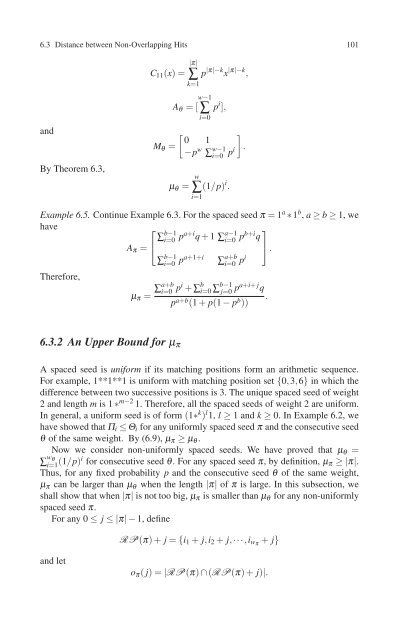You also want an ePaper? Increase the reach of your titles
YUMPU automatically turns print PDFs into web optimized ePapers that Google loves.
6.3 Distance between Non-Overlapping Hits 101<br />
and<br />
By Theorem 6.3,<br />
C 11 (x)=<br />
|π|<br />
∑<br />
k=1<br />
p |π|−k x |π|−k ,<br />
w−1<br />
A θ =[ p i ],<br />
∑<br />
i=0<br />
[ ]<br />
0 1<br />
M θ =<br />
−p w ∑i=0 w−1 .<br />
pi<br />
µ θ =<br />
w<br />
∑<br />
i=1<br />
(1/p) i .<br />
Example 6.5. Continue Example 6.3. For the spaced seed π = 1 a ∗1 b , a ≥ b ≥ 1, we<br />
have<br />
⎡<br />
A π = ⎣ ∑b−1 i=0 pa+i q + 1 ∑ a−1 ⎤<br />
i=0 pb+i q<br />
⎦.<br />
∑ b−1<br />
i=0 pa+1+i ∑ a+b<br />
i=0 pi<br />
Therefore,<br />
µ π = ∑a+b i=0 pi + ∑ b i=0 ∑ b−1<br />
j=0 pa+i+ j q<br />
p a+b (1 + p(1 − p b .<br />
))<br />
6.3.2 An Upper Bound for µ π<br />
A spaced seed is uniform if its matching positions form an arithmetic sequence.<br />
For example, 1**1**1 is uniform with matching position set {0,3,6} in which the<br />
difference between two successive positions is 3. The unique spaced seed of weight<br />
2 and length m is 1 ∗ m−2 1. Therefore, all the spaced seeds of weight 2 are uniform.<br />
In general, a uniform seed is of form (1∗ k ) l 1, l ≥ 1 and k ≥ 0. In Example 6.2, we<br />
have showed that Π i ≤ Θ i for any uniformly spaced seed π and the consecutive seed<br />
θ of the same weight. By (6.9), µ π ≥ µ θ .<br />
Now we consider non-uniformly spaced seeds. We have proved that µ θ =<br />
∑ w θ<br />
i=1 (1/p)i for consecutive seed θ. For any spaced seed π, by definition, µ π ≥|π|.<br />
Thus, for any fixed probability p and the consecutive seed θ of the same weight,<br />
µ π can be larger than µ θ when the length |π| of π is large. In this subsection, we<br />
shall show that when |π| is not too big, µ π is smaller than µ θ for any non-uniformly<br />
spaced seed π.<br />
For any 0 ≤ j ≤|π|−1, define<br />
RP(π)+ j = {i 1 + j,i 2 + j,···,i wπ + j}<br />
and let<br />
o π ( j)=|RP(π) ∩ (RP(π)+ j)|.

















